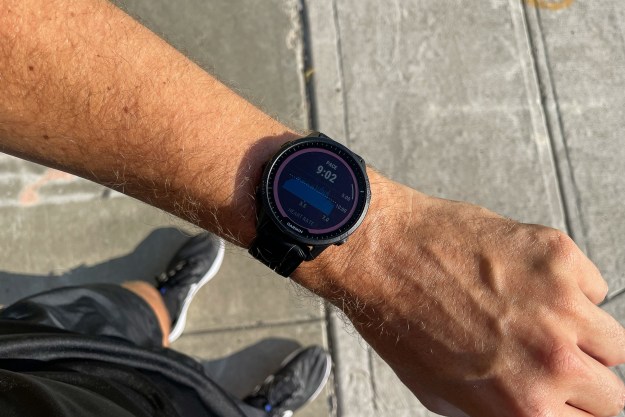At any given moment there are approximately a zillion crowdfunding campaigns on the web. Take a stroll through Kickstarter or Indiegogo and you’ll find no shortage of weird, useless, and downright stupid projects out there – alongside some real gems. In this column, we cut through all the worthless wearables and Oculus Rift ripoffs to round up the week’s most unusual, ambitious, and exciting projects. But don’t grab your wallet just yet. Keep in mind that any crowdfunded project can fail — even the best intentioned. Do your homework before cutting a check for the gadget of your dreams.
GoBoat — Portable, inflatable, single-person motorboat
If you’re a fishing enthusiast trapped in an urban area, you know firsthand how tough it can be tough it can be to get away from it all and go cast a line. If you can’t find a place to keep your boat, or don’t have the scratch to pay for mooring fees, your only option is to buy a trailer and haul your vessel out to the water whenever the urge strikes you — and not everyone has the time or income to make that happen.
That’s where GoBoat comes in. This little bugger is a portable, inflatable, single-person boat that you can easily toss in the back of your 1993 Toyota Camry. The boat is made up of an integrated floor, seat, and motor mounting unit, all encircled by an inflatable ring. When it’s not in use, the ring deflates and the floor folds up, making it small enough to fit into an average hatchback. At 15 pounds (7 kg), it’s also light enough for most people to lift without trouble. When it comes time to hit the lake, it’s simply a matter of using the included pump to inflate the rubber tube and attaching it to the other components.
Reflow — Recycled, socially-conscious 3D printing filament
You might not realize it, but there are people in this world who earn all of their income from picking recyclable materials out of the mountainous piles of garbage that we collectively send off to landfills. Many of these people, known as “pickers,” earn only 10-15 cents per kilogram of plastic they retrieve — and for many, that’s their only income stream. But what if there was a way to increase the value of that plastic, boost the income the pickers can earn on a daily basis, and help lift them out of poverty?
That’s the idea behind Reflow. After seeing the waste collection, trade, and recycling system in Nairobi, Kenya, Reflow co-founder Jasper Middendorf hatched a brilliant plan: Why not take that plastic that the pickers bring in, recycle it, transform it into 3D printing filament, and sell the exact same material for nearly 2,000 percent more money? And that’s exactly what he did. Reflow filament is high-quality PET filament made from recycled plastic gathered by waste pickers — all of whom earn far more money for their efforts as a result. Pretty brilliant, right?
GeoOrbital Wheel — Motorized hub wheel for bicycles
As many popular transportation options make the switch to electric, eBikes are rapidly becoming more and more popular. But if you aren’t interested in splurging on a fully electric bike, a company called GeoOrbital may just have the perfect solution for you. The GeoOrbital wheel is a fully contained electric update that snaps on to virtually any bike in place of the front wheel. In less than 60 seconds, the GeoOrbital wheel lets you go from sweaty morning commuter to electric-powered ease.
The GeoOrbital wheel is powered by a 500-watt brushless DC motor and Panasonic 36-volt lithium-ion battery, which can last for about 30 miles on one charge, or up to 50 miles with pedal assistance. We’re not talking big racing speeds, but going from zero to 20 miles per hour in just six seconds is pretty impressive for a bicycle. All that power is tucked away within the triangular “gear” house that replaces a normal bike wheel’s spokes. Additional batteries could help power longer rides, but even without the electric support, at least you’ll know you’ve got wheels to get where you’re going.
Flatev — Countertop tortilla maker
It is a universally acknowledged fact that every Mexican food enthusiast judges the quality of their south-of-the-border feast based on the all-important tortilla. In the grand culinary scheme of things, there’s little that competes with a freshly made tortilla, and now, thanks to miracles of modern technology, there’s finally a way to bring you that incomparable gratification with the push of a button. Meet the Flatev, otherwise known as the Keurig of tortillas. It’s a countertop device that uses a pod system to create a fresh corn or wheat tortilla in under a minute.
Up until now, having on-demand fresh tortillas in your home was a pipe dream for most of us. But no longer. This genius new device is about the same size as your everyday toaster, but it pops out something far more exciting than sliced bread. Rather, when you feed the Flatev a pod that contains salt, water, corn or wheat flour, and guar flour, you’ll be presented with a six-inch tortilla shortly thereafter. You can choose whether you want it softer or crispier, and of course, whether you want it to be flour- or corn-based. Each pod has a 60-day shelf life, and requires refrigeration — but if your pods don’t last the whole 60 days because you eat them all in one sitting, don’t worry. We won’t judge.
GlassOuse — Head-tracking, bite-activated computer mouse
Now that we’re so saturated with incredible technologies, it’s easy to take little things for granted — things like, say, using a computer mouse. It’s so easy and commonplace for most of us, but for people who have lost their hands or arms, using a computer is a challenging activity. It typically requires a mouth-operated mouse, which can be tricky to learn and painfully slow to operate.
GlassOuse is a totally different approach. Rather than forcing users to push around a joystick with their tongues (as you do with traditional mouth-operated mice), GlassOuse uses a clever head-tracking system to move a cursor across the user’s monitor, and registers clicks with a soft, bite-activated clicker. This configuration is far more intuitive and has a much lower learning curve than the old approach. It’s also far cheaper. GlassOuse units are currently up for pre-order on Indiegogo for just $150, which makes the technology accessible to a broader range of people.




